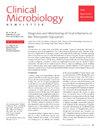Morganella morganii: an opportunistic multidrug-resistant pathogen isolated in ascitic fluid in an old man, case report and literature review
Q3 Medicine
引用次数: 0
Abstract
Morganella morganii is commonly found in nature and is also part of the normal intestinal flora in humans and animals. Although typically an opportunistic pathogen, it is rarely isolated in human infections. Infections caused by this bacterium primarily include postoperative wound infections, urinary tract infections, sepsis, abscesses, chorioamnionitis, and cellulitis. The emergence of multidrug-resistant strains poses a significant public health concern, as these strains can lead to severe or even fatal infections in vulnerable patients. We report the case of a 94-year-old immunocompromised patient admitted to the emergency department with dyspnea, significant ascites, and prolonged fever. A C-TAP scan revealed chronic liver disease with large-volume ascites. Laboratory tests showed a mild inflammatory response (CRP: 14 mg/L), low prothrombin time (PT: 56%), hypoalbuminemia (19 g/L), pancytopenia, and macrocytic anemia. Cytobacteriological analysis of the ascitic fluid revealed a significant neutrophilic response and the growth of Morganella morganii. Antibiotic susceptibility testing showed susceptibility to carbapenems, fluoroquinolones, co-trimoxazole, and chloramphenicol, while resistance was observed against penicillins (aminopenicillins, carboxypenicillins, ureidopenicillins), cephalosporins, fosfomycin/trometamol, and aminoglycosides. The multidrug-resistant strain of Morganella morganii in this case demonstrated concerning resistance to most β-lactams, aminoglycosides, and fosfomycin/trometamol. Given its increasingly opportunistic nature, multidrug resistance, and potential to cause severe nosocomial infections, clinicians must consider this bacterium during the diagnostic process.
莫氏摩根菌:一种从老人腹水中分离出的机会性多重耐药病原菌,病例报告及文献复习
摩氏摩根菌常见于自然界,也是人类和动物正常肠道菌群的一部分。虽然它通常是一种机会性病原体,但在人类感染中很少分离出来。这种细菌引起的感染主要包括术后伤口感染、尿路感染、败血症、脓肿、绒毛膜羊膜炎和蜂窝织炎。耐多药菌株的出现引起了重大的公共卫生关注,因为这些菌株可导致易感患者发生严重甚至致命的感染。我们报告一个94岁的免疫功能低下的病人入院急诊科呼吸困难,明显腹水,并延长发烧。C-TAP扫描显示慢性肝病伴大量腹水。实验室检查显示轻度炎症反应(CRP: 14 mg/L),凝血酶原时间低(PT: 56%),低白蛋白血症(19 g/L),全血细胞减少症和大细胞性贫血。腹水的细胞细菌学分析显示明显的嗜中性反应和摩根氏摩根菌的生长。抗生素药敏试验显示对碳青霉烯类、氟喹诺酮类、复方新诺明和氯霉素敏感,对青霉素类(氨霉素类、羧霉素类、脲霉素类)、头孢菌素类、磷霉素/曲美醇类和氨基糖苷类耐药。在本病例中,多重耐药菌株莫氏摩根菌对大多数β-内酰胺类、氨基糖苷类和磷霉素/曲霉醇具有耐药性。鉴于其日益增加的机会性、多药耐药性和可能导致严重的医院感染,临床医生在诊断过程中必须考虑这种细菌。
本文章由计算机程序翻译,如有差异,请以英文原文为准。
求助全文
约1分钟内获得全文
求助全文
来源期刊

Clinical Microbiology Newsletter
Medicine-Infectious Diseases
CiteScore
2.20
自引率
0.00%
发文量
35
审稿时长
53 days
期刊介绍:
Highly respected for its ability to keep pace with advances in this fast moving field, Clinical Microbiology Newsletter has quickly become a “benchmark” for anyone in the lab. Twice a month the newsletter reports on changes that affect your work, ranging from articles on new diagnostic techniques, to surveys of how readers handle blood cultures, to editorials questioning common procedures and suggesting new ones.
 求助内容:
求助内容: 应助结果提醒方式:
应助结果提醒方式:


